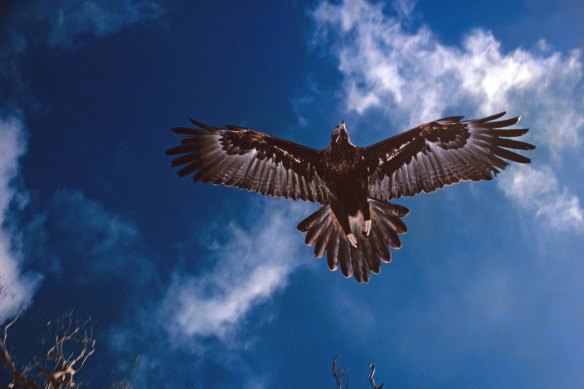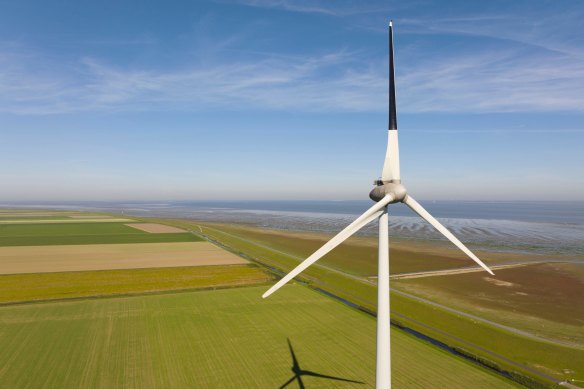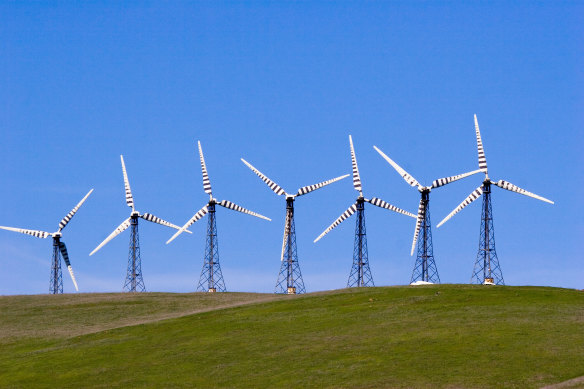- Exclusive
- Environment
- Conservation
- Renewables
The simple fix that could reduce bird deaths from wind farms
The number of birds striking wind turbines could be drastically reduced by simple fixes such as painting one blade black, while technology to detect eagles and stop turbines spinning has paid dividends in Tasmania.
While the claim that offshore wind farms kill whales is false, there are genuine fears about the toll on birds from onshore and offshore wind projects.
A British study published in Global Ecology and Conservation in April 2023 suggests larger birds of prey such as eagles are vulnerable to collisions with turbine blades. While they have good vision, they are often focused on the ground searching for prey.

A wedge-tailed eagle in flight in Australia.Credit: Auscape
There have been cases of wind turbines killing birds of prey in Australia, including endangered Tasmanian wedge-tailed eagles.
Associate Professor Tom Newsome, a wildlife ecologist at the University of Sydney, said there was a lack of good data on eagle populations. He said they played an important role in the ecosystem as an apex predator and a scavenger that “cleaned the landscape of carcasses”.
“With predators, their numbers are typically low in abundance, but they have large home-range sizes, and the main thing they do is they can help regulate numbers of their prey,” Newsome said.
“If you remove the apex predator, the smaller predators – and in Australia, that’s foxes and cats – have no higher order competitor.”

A wind turbine with one blade painted black to reduce collisions with birds.Credit: Alamy Stock Photo
Clean Energy Council policy director Dr Nick Aberle said birds and bats could be killed if they flew into spinning turbine blades, but urged perspective.
“Way more birds are killed by flying into buildings, being hit by cars, or being attacked by feral cats than are affected by wind turbines, and one of the biggest risks to a lot of bird and bat species is climate change,” Aberle said.
He said the fact wind farms reduced greenhouse emissions was “not a get-out-of-jail-free card, but needs to be taken into account”.
In 2020, a Norwegian study found that painting one out of three blades black to increase visibility could cut bird strikes by up to 70 per cent.
The researchers in the 2023 British study found that having black and white striped blades was even better.
An article in Journal of Applied Ecology in February 2021 found IdentiFlight, an automated computer vision system that shuts off wind turbines when it detects eagles, could reduce eagle deaths by 82 per cent.
Aberle said the research was promising, but you could not apply studies from Europe directly to Australia without further research.

Wind turbines with a stripy contrast pattern to make the blades more visible to birds.Credit: Alamy Stock Photo
He said it was complex, noting that wind farms were often required to have night lights on turbines for aviation safety, but that could attract insects, and in turn bats.
In Tasmania, the state’s Environment Protection Authority has not imposed a requirement to paint one blade black, but all wind farm operators are required to report eagle deaths.
One site, Cattle Hill Wind Farm, had about eight eagle deaths in the first three years while trialling IdentiFlight. However, an EPA spokesperson said Cattle Hill Wind Farm had made system improvements after the trial, and no eagles had died there in the past year.
Other Tasmanian wind farms are installing IdentiFlight, and Aberle said he knew of Victorian projects looking at the technology.
On Wednesday, Eliza Budd, senior environment and development planner at Mint Renewables, told the Australian Clean Energy Summit that industry could benefit nature – for example, by restoring wetlands.
The incoming chair of the Climate Change Authority, Matt Kean, told the summit on Tuesday that the renewables industry needed to play a bigger role in combating misinformation and disinformation.
Speaking as the former NSW energy minister before he leaves parliament and takes up the role in early August, Kean said climate deniers had not vacated the field, but were instead spreading propaganda about “when the wind doesn’t blow and the sun doesn’t shine” and “what about the whales?”
He said the slogans were being “drip-fed into Facebook pages and politically motivated rallies up and down the coast and across the state bit by bit, eroding confidence in the value of cheap and clean energy and leaving the transition in a fraught place”.
Kean said he was issuing a “call to arms” for the renewables sector.
“Their claims are fact-free and easy to combat. It should be a task that industry relishes, but the silence has been deafening,” Kean said.
“It makes no sense. The future of the planet is on the line, but so is the fate of the very businesses in which you invest and work.
“You have the tide of capital working to your advantage. You have the backing of science. You can marshal the truth and facts. You have the future on your side. So take on the challenge. Enter the arena. Do it with urgency and confidence.”
Get to the heart of what’s happening with climate change and the environment. Sign up for our fortnightly Environment newsletter.